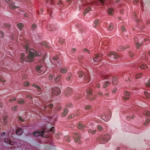Mary Ann Dooley, MD, MPH, associate professor of medicine at the University of North Carolina at Chapel Hill, referred to the lack of data for treating black patients with CY. The rate of lupus in blacks is three times that of whites, Dr. Dooley said. About 40% of black patients treated with six months of CY therapy end up on dialysis at the end of five years, she said, adding that Boumpas and others have reported racial disparities with CY therapy.3-4
Although MMF may be an alternate therapy and can be used in patients who have not responded to IV CY, there are concerns, she said. Most importantly, there are no published long-term follow-up data beyond about three years. The Apreva Lupus Management Trial found that response rates did not vary between MMF and IV CY, she said.
Dr. Dooley said that she would begin treatment in this high-risk patient with six monthly doses of IV CY and then switch to either MMF or AZ with another biopsy before continuing treatment.
Dr. Ginzler cited data from a Food and Drug Administration– funded, randomized, open-label trial that compared the two agents as induction therapy. Those data, she said, suggested that MMF is superior to CY for achieving remission and is also better tolerated. Patients received either MMF or monthly IV CY. The primary endpoint was complete remission at six months; the secondary endpoint, partial remission. An intention-to-treat analysis found that significantly more patients had complete remission with MMF; the partial remission rate was also more frequent with MMF.5
“One needs to consider the long-term effects,” Dr. Ginzler said. “It has been suggested that MMF acid has antiproliferative effects that are not related to immunology of the treatment, with a decrease in smooth muscle cell proliferation, decrease in fibroblast cell proliferation. This effect may be important in the prevention of progression of renal disease to end-stage disease and … for decrease in risk of atherosclerosis in lupus patients,” she said.
Her choice for the 34-year-old black woman would be 3 gm/daily of MMF, building up to that over a month and continuing with the 3-gram dose “as long as tolerated.” At three years, she would consider tapering the MMF and eventually discontinuing it.6 That decision would depend on the patient’s immunologic parameters, her blood pressure, level of serum creatinine, and degree of proteinuria, Dr. Ginzler said.
Dr. Houssiau said that the Euro-Lupus regime is generally the better strategy: Begin with low-dose IV CY, and then treat with AZ. “Induction IV therapy is very important to ensure optimal compliance. We know that noncompliance is a major issue in treatment of lupus long term,” Dr. Houssiau said. AZ is his first choice for maintenance therapy because it costs less, can be continued during pregnancy, and has a good toxicity profile. Results of the MAINTAIN trial, which were presented at the ACR meeting, showed that MMF was not superior to AZ for prevention of renal relapses at a median follow-up of 53 months.7
